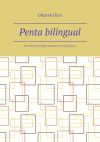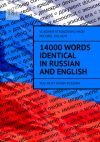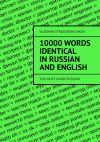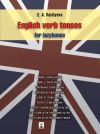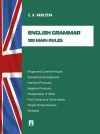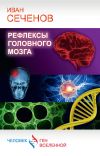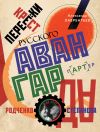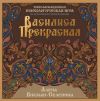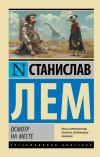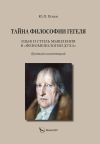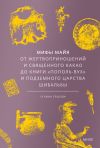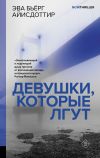Текст книги "Изучаем английский язык. Читаем англоязычную литературу"

Автор книги: Ирина Игнатенко
Жанр: Учебная литература, Детские книги
сообщить о неприемлемом содержимом
Текущая страница: 2 (всего у книги 7 страниц) [доступный отрывок для чтения: 2 страниц]
7. Change of meaning
Word-meaning is liable to change in the course of the historical development of language. The factors accounting for semantic change can be roughly subdivided into two groups: a) extra-linguistic and b) linguistic causes.
By extra-linguistic causes we mean various changes in the life of the speech community, changes in economic and social structure, changes in ideas, scientific concepts, way of life and other spheres of human activity. The word CAR, e.g., goes back to Latin CARRUS which meant “a four-wheeled wagon” but now when other means of transport are used it denotes “a motor-car”.
Some changes of meaning are due to what may be described as purely linguistic causes, i.e. factors acting within the language system. The verb TO STARVE, e.g. in Old English (STEORFAN) had the meaning “to die” and was usually used in collocation with the word HUNGER. Already in the 16th century the verb itself acquired the meaning “to die of hunger”.
Generally speaking, a necessary condition of any semantic change is some association between the old meaning and the new. There are two associations involved in various semantic changes: SIMILARITY OF MEANINGS and CONTIGUITY OF MEANINGS.
SIMILARITY OF MEANINGS or METAPHOR may be described as a semantic process associating two referents, one of which in some way resembles the other. The word HAND, e.g., acquired in the 16th century the meaning of ‘a pointer of a clock or watch” because of the similarity of one of the functions performed by the hand (to point at smth) and the function of the clockpointer.
CONTIGUITY OF MEANING or METONYMY may be described as the semantic process of associating two referents one of which makes part of the other or is closely connected with it. This can be best illustrated by the use of the word TONGUE (the organ of speech) in the meaning of ‘language” (as in MOTHER TONGUE).
Assignment:
• Speak on the factors effecting the change of word– meaning. Find examples of words in the Russian language that underwent similar change.
8. Polysemy and homonymy
Polysemy. When analyzing the word-meanings we observe that words as a rule are not units of a single meaning. MONOSEMANTIC WORDS, i.e. words having only one meaning are comparatively few in number; these are mainly scientific terms, such as HYDROGEN, MOLECULE and the like. The bulk of English words are POLYSEMANTIC, that is to say possess more than one meaning. The actual number of meanings of the commonly used words ranges from five to about a hundred. In fact, the commoner the word the more meanings it has.
The word TABLE has at least 9 meanings in Modern English:
1. a piece of furniture (стол)
2. the persons seated at a table (застолица)
3. (sing.) the food put on a table, meals (пища, еда)
4. a thin flat piece of stone, metal, wood, etc. (плита)
5. (pl.) slabs of stone (with words written on them or cut into them) (скрижали)
6. words cut into them or written on them (the ten tables) (заповеди)
7. an orderly arrangement of facts, figures (таблица)
8. part of a machine-tool on which the work is put to be operated on (планшайба)
9. a level area, a plateau (плато)
The problem of polysemy is mainly the problem of interrelation and interdependence of the various meanings of the same word. Polysemy viewed diachronically is a historical change in the semantic structure of the word resulting in disappearance of some meanings (or) and in new meanings being added to the ones already existing and also in the rearrangement of these meanings in its semantic structure.
Polysemy viewed synchronically is understood as co-existence of various meanings of the same word at a certain historical period and the arrangement of these meanings in the semantic structure of the word.
The concept of central (basic) and marginal (minor) meanings may be interpreted in terms of their relative frequency in speech. The meaning that first occurs to us whenever we hear or see the word TABLE is ‘an article of furniture.’ This is the basic or the central meaning of the word and all other meanings are minor in comparison.
Homonymy. Words identical in sound-form but different in meaning are traditionally termed HOMONYMS. Modern English is exceptionally rich in homonymous words and word-forms. It is held that languages where short words abound have more homonyms than those where longer words are prevalent.
The problem of homonymy is mainly the problem of differentiation between two different semantic structures of identically sounding words. When analyzing different cases of homonymy we find that some words are homonymous in all their forms, i.e. we observe FULL HOMONYMY e.g. SEAL (a sea animal) and SEAL (a design printed on paper by means of a stamp). PARTIAL HOMONYMY is usually to be found in word-forms of different parts of speech. SEAL (noun) – seal’s, seals, seals’ TO SEAL (verb) – seal, seals, sealed, sealing.
Homonymous words and word-forms may be classified by the type of meaning that serves to differentiate between identical sound-forms. LEXICAL HOMONYMS differ in lexical meaning, e.g. SEAL(a sea animal) and SEAL (a design printed on paper…), LEXICO-GRAMMATICAL homonyms differ in both lexical and grammatical meanings SEAL (noun), TO SEAL (verb), GRAMMATICAL HOMONYMS are those that differ in grammatical meaning only, e.g., ASKED (Past tense), ASKED (Participle2), BROTHER’S ( Possessive Case Singular), BROTHERS (The Common Case Plural).
If the graphic form of homonyms is taken into account, they are classified on the basis of the three aspects – sound-form, graphic form and meaning – into three big groups: HOMOGRAPHS ( identical graphic form, but different in both sound-form and meaning, e.g. BOW n [bou] (a piece of wood curved by a string and used for shooting arrows) and BOW n[bau] (the bending of the head or body), HOMOPHONES (identical in sound-form but different in both spelling and in meaning, e.g. SEA n and SEE v, SUN n and SON n, PERFECT HOMONYMS (identical both in spelling and sound-form but different in meaning, e.g. CASE n (something that has happened) and CASE n (a box, a container).
Assignments:
• Speak on the diachronic and synchronic approach to polysemy.
• Give a classification of homonyms.
9. Synonymy and antonymy
Lexical units can be classified by the criterion of semantic similarity and semantic contrasts. The terms generally used to denote these two types of semantic relatedness are SYNONYMY and ANTONYMY.
SYNONYMS are traditionally described as words different in sound-form but identical or similar in meaning. This definition has been severely criticized. Sometimes it is impossible to speak of identical or similar meaning of words as such as this part of definition cannot be applied to polysemantic words. The verb LOOK is usually treated as a synonym of SEE, WATCH, OBSERVE, etc., but in another of its meanings it is not synonymous with this group of words but rather with the verbs SEEM, APPEAR (to look at smb and to look pale).
It seems impossible to speak of identity or similarity of lexical meaning as a whole as it is only the denotational component that may be described as identical or similar. If we analyse words which are usually considered synonymous, e.g., TO DIE, TO PASS AWAY; TO BEGIN, TO COMMENCE, we find that connotational component or the stylistic reference of these words is entirely different. Differentiation of synonyms may be observed in different semantic components – denotational or connotational. Synonyms that differ in the denotational meaning are called ideographic synonyms and those that differ in connotational meaning are called stylistic synonyms.
The relationship between synonyms of one synonymic set can be different, because each word has its own shade of meaning and one word is more general in meaning. For example in one synonymic set– TO LOOK, TO GLANCE, TO STARE, TO VIEW, TO EYE, TO PEEP – the word TO LOOK is the most general in meaning.
Thus a more acceptable definition of synonyms seems to be the following: synonyms are words different in their sound-form, but similar in their denotational meaning and interchangeable at least in some contexts.
The English word-stock is extremely rich in synonyms which can be accounted for by abundant borrowings. Quite a number of words in synonymic sets are usually of Latin or French origin. A characteristic pattern of English synonymic sets is the pattern including the native and the borrowed words: native versus Latin (bodily-corporal, brotherly-fraternal), native versus Greek or French (answer-reply, fiddle-violin). In most cases the native word is usually colloquial whereas the borrowed word may as a rule be described as bookish or highly literary.
ANTONYMY in general shares many features typical of synonymy. Like synonyms, perfect or complete antonyms are rare. It is universally recognized that among the cases that are traditionally described as antonyms there are the following groups:
1. CONTRADICTORIES which represent the type of semantic relations that exist between pairs like DEAD and ALIVE, SINGLE and MARRIED.
2. CONTRARIES differ from contradictories mainly because contradictories admit of no possibility between them. One is either SINGLE or MARRIED, either DEAD or ALIVE, whereas contraries admit such possibilities. This may be observed in COLD-HOT, and COOL and WARM which seem to be intermediate members.
Interchangeability in certain contexts is typical of antonyms. In a context where one member of the antonymous pair can be used, it is, as a rule, interchangeable with the other member. For instance, if we take the words DRY and WET to be antonymous, they must be interchangeable in the same context (A WET SHIRT – A DRY SHIRT).
It is therefore suggested that the term ANTONYMS should be used as a general term to describe words different in sound-form and characterized by different types of semantic contrast of denotational meaning and interchangeability at least in some contexts.
Questions:
1. Why is English extremely rich in synonyms?
2. What is the difference between contradictories and contraries?
10. Word-formation
Word-formation is the process of creating words from the material available in the language after certain structural and semantic formulas and patterns. For example, the noun DRIVER is formed after the pattern V+-ER. Ways of forming words in present-day English are divided into productive and non-productive. Productive ways of word-formation are: AFFIXATION, CONVERSION, WORD-COMPOSITION (or word-compounding), and SHORTENING. Non-productive ways of word-formation are SOUND– and STRESS-INTERCHANGE (to know– knew, to live– life man-men; ‘export (n)-to ex’port(v), ‘conduct(n) –to con’duct).
PRODUCTIVE WAYS OF WORD-FORMATION
Affixation is generally defined as the formation of words by adding derivational affixes to different types of bases. Affixes are divided into suffixes and prefixes.
Prefixation is the formation of words with the help of prefixes. There are about 51 prefixes in Modern English. Prefixes form new words within certain part of speech (e.g. reasonable-unreasonable, read-reread). Prefixes are usually described either in alphabetical order or subdivided into several classes in accordance with their origin, meaning or function but never according to the part of speech.
PRODUCTIVE PREFIXES
UN– negative, corresponds to Russian НЕ (happy-unhappy)
PRE– prefix of time and order, corresponds to Russian ПРЕД– (predisposition-предрасположение, pre-war-довоенный)
POST– prefix of time and order, (post-war, post-impressionist)
RE– repetition (write-rewrite)
COUNTER– corresponds to Russian противо-, контр– (counteraction-противодействие, counter-attack-контратака, ANTI-corresponds to Russian противо-, анти– (antitank – противотанковый, antifascist – антифашист).
IN– negative prefix (inconvenient, inactive).It may occur in different phonetic shapes depending on the initial sound of the base, it becomes IL– before L, IM-before P, M, IR– before R (illegal, improbable, immaterial, irregular).
NON-PRODUCTIVE PREFIXES
MIS– to show that something has been done in the wrong way (misinform – неправильно информировать, misname – неверно называть, mispronounce,)
OUT– corresponds to Russian превзойти в ч-л (outnumber-превзойти численностью)
DIS-negative prefix (disbelieve, dislike, disappear, disorder)
Suffixation is the formation of words with the help of suffixes. Suffixes usually modify the lexical meaning of the base and transfer words to A DIFFERENT PART OF SPEECH. There are different classifications of suffixes in linguistic literature, as they can be divided into several groups according to different principles. The first principle is the PART OF SPEECH FORMED:
a) noun-suffixes i.e. those forming or occurring in nouns, e.g. –er, -dom, -ness, -ation, -ist, -ess, -ism, -ing, etc. (teacher, freedom, kindness, classification, socialist, hostess, classicism, teaching).
b) adjective– suffixes e.g. –able, -less, -ful, -ic, -ous, -ish, -ed, etc. (agreeable, heartless, beautiful, poetic, courageous, childish, dark-haired)
c) verb-suffixes e.g., -en, -fy, -ize etc., (strengthen, satisfy, organize, etc.)
d) adverb-suffixes e.g. –ly, -ward (quickly, eastward)
NON-PRODUCTIVE SUFFIXES
-EN (to deepen, weaken)
–FY, -IFY (intensify, glorify, beautify).
Assignment:
• Underline suffixes or prefixes in the words and say how they change or add to the meaning of the root/word: misunderstand, enjoyment, motherhood, antisocial, qualified, replace, journalism, ex-wife, irreplaceable, impatient, arrangement, physicist, addressee, actor, submarine, bottle-opener, donation, homeless, modernized, partnership, happiness, disagree, unwrap, pollution, microwave, postgraduate, brotherhood, oversleep, handful, childish.
11. Conversion
CONVERSION, one of the principal ways of forming words in Modern English, is highly productive in replenishing the English word-stock with new words. The term CONVERSION refers to the numerous cases of phonetic identity of word-forms of two words belonging to different parts of speech, e.g. work (n) –to work (v), water (n) – to water (v).
1. VERBS CONVERTED FROM NOUNS
a) action characteristic of the object e.g. APE(n)-TO APE– imitate in a foolish way, BUTCHER (n) – TO BUTCHER – kill animals for food, cut up a killed animal
b) instrumental use of the object, e.g. WHIP(n) – TO WHIP – strike with a whip
c) acquisition or addition of the object, e.g. COAT(n)-covering of paint – TO COAT –put a coat of paint on
d) deprivation of the object, e.g. DUST(n) – TO DUST– remove dust from something
2. NOUNS CONVERTED FROM VERBS
a) instance of the action, e.g. TO JUMP(v) – JUMP-sudden spring from the ground, TO MOVE(v) – MOVE – a change of position
b) agent of the action, e.g. TO HELP(v) – HELP –a person who helps, TO BORE(v)– BORE– a person that bores
c) place of action, e.g. TO DRIVE(v) – DRIVE– a path or road along which one drives, TO WALK(v) – WALK –a place for walking
d) object or result of the action, e.g. TO PEEL(v) – PEEL– the outer skin of fruit or potatoes taken off , TO FIND(v) – FIND –smth found, esp. smth valuable or pleasant.
Assignment:
• Speak about conversion as a productive way of replenishing the English word-stock with new words. Give examples.
12. Word-composition
COMPOUNDING or WORD-COMPOSITION is one of the productive types of word-formation in Modern English. The structural and semantic centre of a compound, i.e. its head-member is its second IC (Immediate Constituent), which preconditions the part of speech the compound belongs to and its lexical class.( OIL-RICH, WEEK-END).
Phonetically compound words are marked by three stress patterns – a unity stress (/HONEYMOON, /DOORWAY), a double stress, with a primary stress on the first component, secondary stress on the second component (/WASHING-MA/CHINE) and a level stress (/ARM-/CHAIR, /ICY-/COLD).
Graphically as a rule compounds are marked by two types of spelling – solid spelling (KEYHOLE, EARTHQUAKE) and hyphenated spelling (SNOW-WHITE).
The meaning of compound words is derived from the combined lexical meaning of the components and the meaning of the derivational pattern.
Composition is typical in Modern English mostly of nouns and adjectives.
THE STRUCTURAL TYPES OF COMPOUND NOUNS
1. n+n (lamp-shade, night-school)
2. adj+n (black-cock – тетерев)
3. v+n (scatter-brain – ветренник, вертопрах, breakstone – щебень)
4. n+prep.+n (man-of-war – военный корабль, son-in-law –з ять)
5. n+conj+n, or v+conj+v (bread-and– butter –бутерброд, come-and-go – движение взад и вперед)
THE STRUCTURAL TYPES OF COMPOND ADJECTIVES
1. adj+n +-ed (open-faced, grey-haired)
2. numeral+n (ten-year, two-room)
3. n+adj (world-wide, life-long)
4. n+PI (peace-loving)
5. n+ PII (snow-covered, brickbuilt)
6. adj+adj (red-hot, dark-blue)
7. adv+PI (ill-fitting)
8. adj+PI (tired-looking, military-looking)
9. adv+PII (hard-worn, well-read)
10. adj (geographical names – Anglo-Saxon, Indo-European)
Assignments:
• Speak about the semantic structure of a compound.
• Give examples of stress and spelling patterns of compounds.
• Find different examples of structural types of compound nouns and compound adjectives.
13. Other ways of word-creation
Shortening is a very productive way of replenishing the Modern English word-stock. Distinction should be made between shortening which results in new LEXICAL items and a specific type of shortening proper only to written speech resulting in numerous graphical abbreviations which are only signs representing words and word-groups of high frequency of occurrence in various spheres of human activity as for instance, ST for STREET, Dr. = DOCTOR, MR. = MISTER.
Transformations of word-groups into words involve different types of shortening: ellipsis or substantivization, initial letter or syllable abbreviations (also referred to as acronyms), blendings, etc.
Substantivization consists in dropping of the final nominal member of a frequently used attributive word-group. (a documentary film = a documentary, the final examinations = the finals, an editorial article = an editorial.)
Acronyms and letter abbreviations are lexical abbreviations of a phrase. (DOD = Department of Defence, ITV = Independent Television, D.J. = disc jockey, M.C. (emcee) = master of ceremony).
ACRONYMS are regular vocabulary units spoken as words. They are formed in various ways:
a) from initial letters or syllables of a phrase, e.g. UNO, NATO, UNESCO, BBC, MP, SOS, etc.
b) from the initial syllables of each word of the phrase ,e.g. INTERPOL = international police
c) by a combination of the abbreviation of the first or the first two members of the phrase with the last member undergoing no change at all, e.g. V-DAY, H-BOMB.
Blendings are the result of conscious creation of words by merging irregular fragments of several words (BRUNCH=breakfast and lunch, SMOG = smoke and fog, OXBRIDGE= Oxford and Cambridge).
Clipping refers to the creation of new words by shortening a word of two or more syllables without changing its class membership (BUS=omnibus, BIKE= bicycle. EXAM=examination, LAB=laboratory, FLU=influenza
Assignment:
• Give the summary of the text.
14. Implications for language teaching
Why is it important to know what is difficult or easy in learning a second language?’ Why should we care what is easy and what is hard in second language acquisition? Well, it’s very clear. If teachers understand what is hard to learn, they can spend more time in the classroom practicing it with their students. If students understand what is hard to learn, they will pay attention to the grammar morphemes, the little words and endings of words, not only when studying, but also when speaking. Learning those little words and endings is hard. It is even harder to use them automatically without thinking in second language speech. But they are indispensable. And they are worth the effort. Practice makes them perfect. Remember, in second language acquisition, as well as in many other things in life, no pain, no gain.
Classroom culture
Classrooms are communities, but it is important to remember that they are not all the same. The individual members of the community are different people, with different personalities and different personal biographies, and classrooms have also emerged from very different social and historical circumstances and contexts. The role of the school – and the teacher – is viewed very differently in different societies and at different times in history.
Let’s discuss how classroom culture can impact learning and consider how local teaching context is crucial in defining classroom practices. Is it the role of the classroom teacher to be an imparter of knowledge to their students? A carer and stand-in parent? A moral guide? Should the aim of classroom pedagogy be to produce creative individuals, good citizens of the state, or young people with a toolkit of skills which fit them for the world of work? And is it the job of the teacher to offer individual students maximum choice and different learning paths, or to ensure that the whole group of students in their charge progress to common goals? In different societies, somewhat different answers have been given to such central questions underpinning educational practice, in different social contexts.
The answers adopted in different times and places are related to the historical development of schools, and the expectations held of schools by wider society.
Cutting across this underlying set of local educational expectations and assumptions, language teaching in the 20th century saw the introduction of ‘modern’ methods, seen as universally applicable and acceptable, such as the ‘communicative approach’, or ‘task based learning’. These methods have achieved considerable impact, again partly because of wider social change, rather than necessarily any intrinsic ‘scientific’ superiority over older methods. They are well adapted to a number of broad shifts in language education goals:•The rise in economic prosperity and therefore in universal schooling during the 20th century, which has seen language teaching spread far beyond a small elite;
• A shift in views of the underlying purposes of education, away from the transmission of high culture (which for languages, meant giving priority in schools to grammar and to literature), toward more utilitarian goals;
• A ‘standards based’ philosophy of education, which views educational success as the achievement of measurable and pre-determined learning outcomes (reflected for languages, for example, in documents such as the Common European Framework of Reference for Languages: Council of Europe, 2001);
• Increased emphasis on the development of communication skills, and of oral fluency in particular.
However, this international promotion of particular approaches to language pedagogy has not been without its critics. Numerous teachers in local contexts have struggled to apply such concepts as ‘learner-centredness’ or ‘learner autonomy’, finding that such externally promoted ideas clashed with deeply rooted cultural assumptions about teacher-student relations and effective classroom practices. Many teachers preferred to adapt the procedures suggested in the Teachers’ Book to produce workable teaching plans according to their own circumstances and teaching beliefs.
Researchers have criticised attempts to override local educational cultures through Western-imposed curriculum projects, involving the routinisation and prescription of particular teaching practices. Instead they argue for local solutions to local educational problems, and for what he terms “cultural continuity”:
Questions:
1. Speak about your classroom culture. What is the role of the teacher?
2. Do your classmates learn from each other in the classroom?
Внимание! Это не конец книги.
Если начало книги вам понравилось, то полную версию можно приобрести у нашего партнёра - распространителя легального контента. Поддержите автора!Правообладателям!
Данное произведение размещено по согласованию с ООО "ЛитРес" (20% исходного текста). Если размещение книги нарушает чьи-либо права, то сообщите об этом.Читателям!
Оплатили, но не знаете что делать дальше?